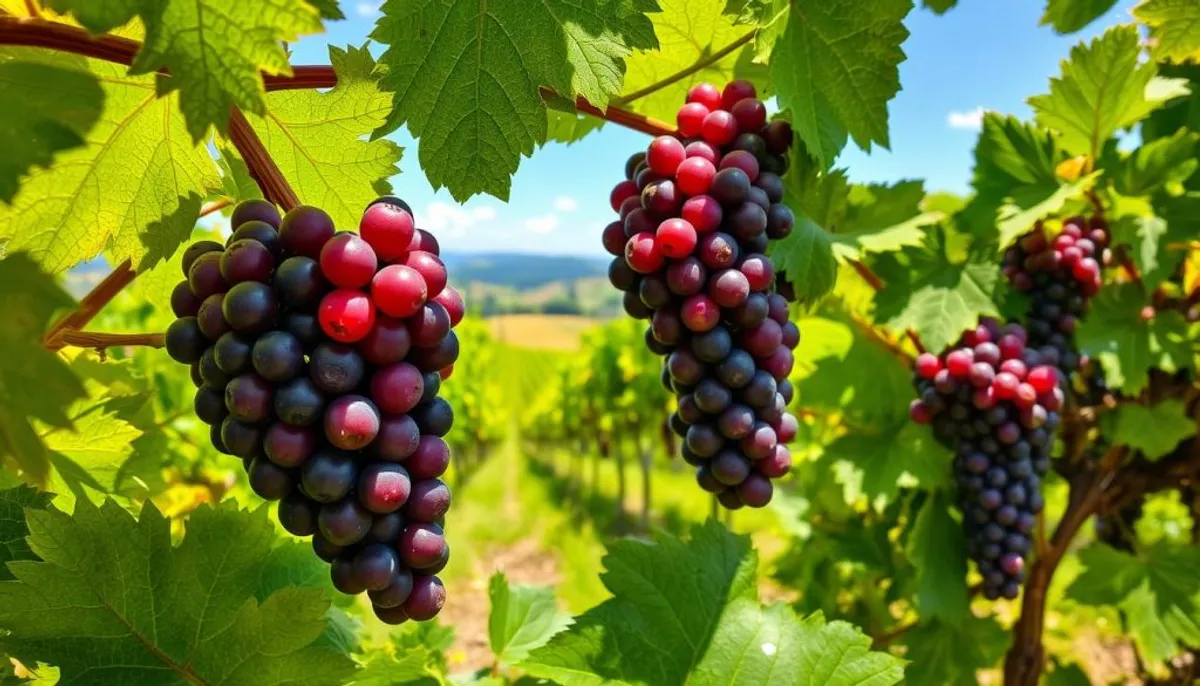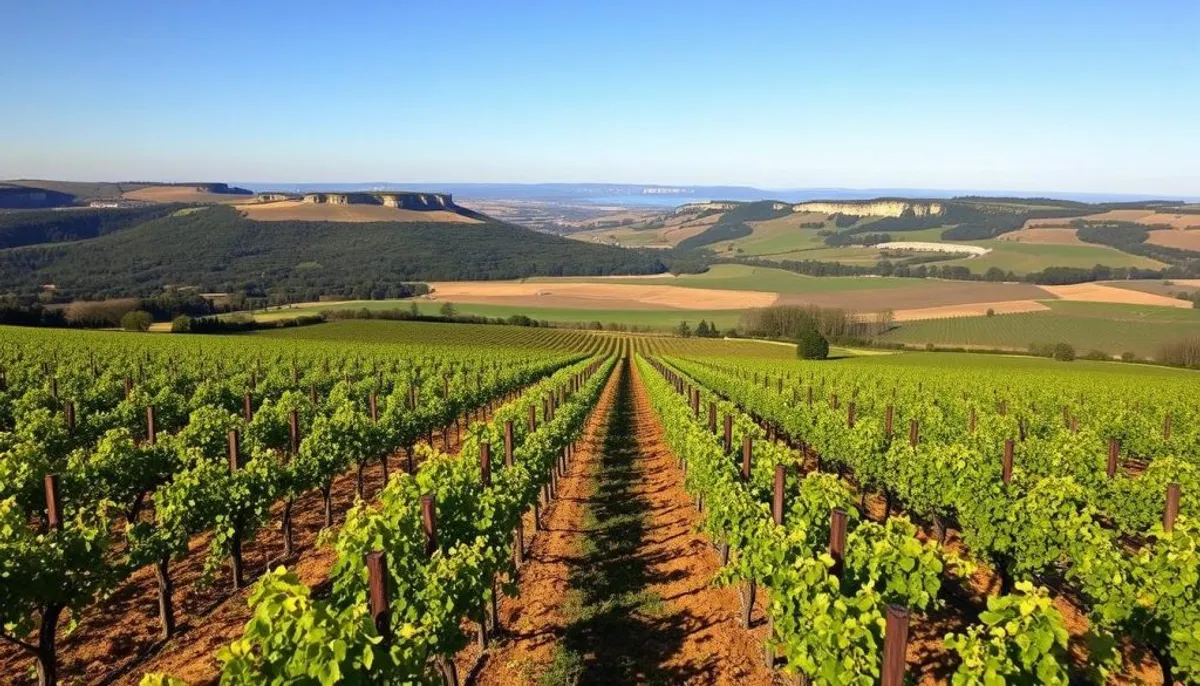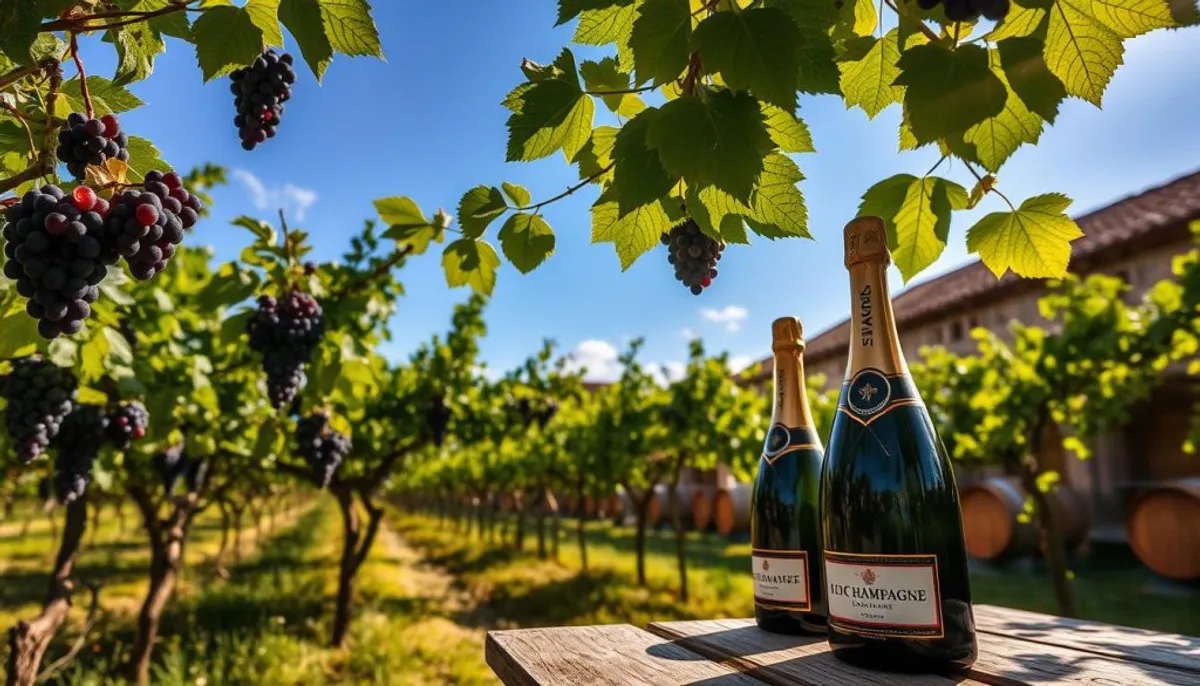Pinot Noir is a cornerstone in French winemaking, pivotal in the realm of luxury champagne. This noble grape variety imbues sparkling wines with elegant complexity. It crafts a symphony of flavors that elegantly dance on the palate.
The Reims mountain region, with its sun-kissed hillsides and chalky soils, offers the perfect environment for Pinot Noir to flourish. Here, this ancient grape variety excels, contributing to the creation of world-renowned champagnes.

Pinot Noir’s role in champagne production is indispensable. It imparts structure and depth to the wines, introducing subtle red fruit aromas. These aromas blend harmoniously with other varieties, resulting in sparkling wines of exceptional quality and character.
Key Takeaways
- Pinot Noir is crucial in producing luxury champagne
- The Reims region’s terroir is ideal for growing Pinot Noir
- Pinot Noir adds structure and depth to sparkling wines
- It contributes subtle red fruit aromas to champagne
- Pinot Noir enhances the elegant complexity of fine champagnes
The Ancient Heritage of Pinot Noir in Champagne
Pinot Noir’s narrative in French wine history is as profound as the wine itself. This grape variety, a cornerstone in Burgundy and Champagne, boasts a legacy spanning over two millennia.
Origins in Burgundy: A Historical Perspective
Pinot Noir’s origins date back to before the first century A.D., making it one of the oldest grape varieties known. Its importance in traditional winemaking was solidified when Benedictine monks designated it as the official wine for Communion. They recognized its superior quality.
Evolution Through Centuries
The grape’s journey through French wine history is punctuated by pivotal events. Until the French Revolution in 1789, Burgundy’s vineyards, mainly growing Pinot Noir, were church-owned. Over two centuries, more than a thousand Pinot Noir clones have been registered. This showcases its adaptability and enduring popularity.
Traditional Significance in French Winemaking
Pinot Noir’s role in traditional winemaking transcends still wines. It is a crucial component in Champagne production, often blended with Chardonnay and Pinot Meunier to create exquisite sparkling wines. This versatility has solidified Pinot Noir’s position in France’s winemaking tradition.
| Characteristic | Description |
|---|---|
| Age | Over 2,000 years |
| Historical Use | Communion wine |
| Ownership Pre-1789 | Church-owned vineyards |
| Registered Clones | Over 1,000 |
| Key Regions | Burgundy, Champagne |
Understanding Champagne Pinot Noir Production
Champagne production is a meticulous art that demands expertise, patience, and meticulous attention to detail. The journey of creating Champagne Pinot Noir commences with the cultivation of grapes in the Reims mountain region. This locale’s unique terroir, characterized by chalky soil and sun-kissed hillsides, fosters an optimal environment for Pinot Noir grapes.
The process begins with the meticulous hand-harvesting of grapes, a method that guarantees the selection of only the highest quality fruits. Pinot Noir, accounting for approximately 38% of Champagne’s grape varieties, ripens earliest and possesses the highest sugar content. Its robust skins are well-suited for south or south-west facing slopes.
Following harvesting, the winemaking process advances with pressing and fermentation. The juice undergoes primary fermentation in tanks or barrels, followed by a blending phase. Renowned Champagne houses, such as Bollinger and Veuve Clicquot, frequently incorporate 50-65% Pinot Noir into their blends.
The subsequent critical phase is the secondary fermentation, which takes place within the bottle. This stage, lasting at least 15 months for non-vintage Champagnes and 36 months for vintage ones, is essential for generating the distinctive bubbles and intricate flavors characteristic of Champagne.
| Champagne Type | Aging Period | Sugar Content (g/L) |
|---|---|---|
| Non-Vintage | 15+ months | Varies |
| Vintage | 36+ months | Varies |
| Prestige Cuvée | 5+ years | Varies |
| Brut Nature | Varies | 0-3 |
| Demi-sec | Varies | 33-50 |
The concluding stages of Champagne production involve riddling, where bottles are gradually turned and tilted to collect sediment in the neck, and disgorging, which removes this sediment. The final step is the addition of dosage, a blend of wine, sugar, and sometimes brandy, to achieve the desired sweetness level. This is followed by corking and labeling.
The Terroir of Reims Mountain Region
The Reims terroir is pivotal in defining Champagne’s essence. Situated 30 kilometers east to west and 6-10 kilometers north to south, it offers prime conditions for Pinot Noir cultivation. This region’s unique environment is essential for the production of high-quality Champagne.
Chalky Soil Composition
The Montagne de Reims is celebrated for its chalky soil, a cornerstone of the Champagne region’s terroir. This terrain, encompassing 9 Grand Cru villages, ensures optimal drainage and mineral content for Pinot Noir vines. The chalky soils are responsible for the wines’ crisp acidity and distinctive mineral notes.

Climate and Sun Exposure
The region’s cool climate and gentle slopes provide ideal conditions for Pinot Noir grapes. This environment facilitates slow, steady ripening, leading to grapes with complex flavors and balanced acidity. The unique microclimate of Montagne de Reims is instrumental in crafting robust, fragrant Champagnes.
Geographical Advantages
The geographical layout of Montagne de Reims fosters a diverse array of terroirs. Spanning 7,989.3 hectares across 94 communities, each terroir imparts unique characteristics to the wines. This diversity enables winemakers to create complex blends, showcasing the full spectrum of Reims terroir. For those looking to explore the best options, there are also top champagne deals in kenya available that highlight this exquisite variety.
| Feature | Impact on Wine |
|---|---|
| Chalky Soil | Enhances mineral notes, improves drainage |
| Cool Climate | Preserves acidity, promotes slow ripening |
| Gentle Slopes | Optimizes sun exposure, aids water management |
| Diverse Terroirs | Allows for complex blending, unique flavor profiles |
The Art of Blending with Pinot Noir
Champagne blending is an intricate art, combining various grape varieties to forge exquisite cuvées. In the Champagne region, Pinot Noir occupies 38% of vineyard space, playing a pivotal role in cuvée creation.
Harmony with Chardonnay
Pinot Noir and Chardonnay form a quintessential duo in champagne. Chardonnay, which covers 30% of Champagne vineyards, contributes delicacy and length. This synergy balances the wine’s structure and body. A 100% Chardonnay blend, known as Blanc de Blancs, is ideal for seafood pairings.
Balance with Pinot Meunier
Pinot Meunier, making up 31% of Champagne vineyards, harmonizes with Pinot Noir. It introduces roundness and intensity, with notes of raspberry and green apple. Some producers, like Krug, incorporate up to 20% Pinot Meunier in their prestige cuvées, highlighting its significance in champagne blending.
Creating Perfect Cuvées
Creating the perfect cuvée requires a delicate balance of fruity and floral characters, mouthfeel, and vintages. Large champagne houses might blend up to 100 different base wines for a non-vintage cuvée. Krug’s Grande Cuvée, for instance, combines 120 base wines from ten or more years. This meticulous approach ensures each champagne retains its unique identity and quality over time.
| Grape Variety | Vineyard Coverage | Characteristics |
|---|---|---|
| Pinot Noir | 38% | Power, body, red fruit aromas |
| Chardonnay | 30% | Delicacy, subtlety, length |
| Pinot Meunier | 31% | Roundness, intensity, rapid evolution |
Aromatic Profile and Characteristics
Pinot Noir infuses champagne with a unique charm, refining its flavor profile with elegance. As the 6th most planted red grape globally, it significantly enriches the wine’s aromatic complexity. Let’s dive into the distinct champagne aromas Pinot Noir brings.
Wine tasting notes for Pinot Noir-based champagnes frequently mention subtle red fruit flavors. Cherry and raspberry are prominent descriptors, offering a delightful sensory journey. These fruity notes harmonize with other grape varieties, creating sparkling wines of unparalleled depth.
The Bruno Paillard Première Cuvée Champagne exemplifies this. Its fine bubbles caress the palate, while vibrant fruit notes tantalize the tongue. This sensory experience is largely attributed to its Pinot Noir content, highlighting the grape’s role in enhancing champagne’s essence.
| Aroma Profile | Flavor Notes | Texture |
|---|---|---|
| Red fruits | Cherry, Raspberry | Fine bubbles |
| Floral hints | Rose petals | Crisp |
| Subtle spice | White pepper | Elegant |
Pinot Noir’s influence on champagne goes beyond flavor. It adds structure, body, and complexity to the wine. Celebrated annually on August 18th as Pinot Noir Day, this grape excels in champagne production, elevating both aroma and taste.
Expert Winemaking Techniques
Champagne production is a meticulous art form, demanding precision and profound expertise. At its core lies the méthode traditionnelle, a set of techniques that distinguish this sparkling wine. These methods are integral to its creation, including the importance of lighting for champagne photos to enhance the visual appeal of the final product.
Traditional Method Process
The méthode traditionnelle commences with a base wine. A second fermentation ensues within the bottle, generating the wine’s characteristic effervescence. This phase is pivotal for the development of intricate flavors and fragrances.

Aging and Maturation
Sur lie aging is a critical phase in champagne production. During this period, wines rest atop dead yeast cells, refining their taste and texture. Many champagnes undergo extended aging, resulting in rich, toasty nuances.
Quality Control Standards
Champagne production adheres to stringent standards, ensuring quality consistency. The Comité Interprofessionnel du vin de Champagne (CIVC) oversees every detail, from the timing of harvests to the volume of wine produced.
| Champagne Style | Sugar Content (g/L) | Aging Time |
|---|---|---|
| Extra Brut | 0-6 | 15+ months |
| Brut Nature | 0-3 | 15+ months |
| Vintage | Varies | 36+ months |
These refined techniques yield champagnes with unique profiles. Ranging from the dry Extra Brut to the complex vintage varieties, each bottle showcases the dedication and craftsmanship invested in its production.
Food Pairing Excellence
Champagne Pinot Noir excels in wine and food pairing, opening up a vast realm of champagne gastronomy. Its adaptability enables the creation of thrilling pairings that elevate the dining experience.
Classic Combinations
Pinot Noir-based champagnes pair magnificently with poultry, salmon, and soft cheeses. The wine’s framework complements these dishes, resulting in a symphony of flavors. A glass paired with roasted duck or brie promises a memorable taste journey.
Modern Culinary Pairings
Delve into the uncharted territories of champagne gastronomy by pairing Pinot Noir champagnes with unconventional dishes. Sushi, truffle risotto, or even gourmet tacos can forge novel flavor combinations. The wine’s depth can stand up to robust flavors while accentuating delicate nuances.
Serving Recommendations
To fully appreciate Champagne Pinot Noir, the serving temperature is crucial. Aim for 45-50°F (7-10°C) to highlight the wine’s attributes. Utilize tulip-shaped glasses to focus aromas and enrich the tasting experience.
| Dish | Champagne Style | Serving Temperature |
|---|---|---|
| Fried Chicken | Brut Rosé | 45°F (7°C) |
| Grilled Salmon | Blanc de Noirs | 48°F (9°C) |
| Mushroom Risotto | Vintage Brut | 50°F (10°C) |
The quintessential wine and food pairing is one that brings joy. Venture into different combinations to uncover your preferred Champagne Pinot Noir pairings.
Global Market and Export Opportunities
The international wine market has witnessed a significant increase in champagne exports, with Champagne Pinot Noir at the forefront. In 2023, the global champagne market valuation soared to USD 7.19 billion. Analysts forecast a 4.6% annual growth rate from 2024 to 2030, projecting a market value of USD 9.83 billion by 2030. Additionally, the rise of south african champagne has contributed to this growth, showcasing the diversity in the champagne sector.
Europe’s dominance in the champagne industry is evident, holding a 66% market share in 2023. The luxury beverage sector is experiencing a shift in consumer preferences, with Blanc de Blancs champagne leading at 26% revenue share. Rosé champagne, on the other hand, is expected to exhibit the most rapid growth in the coming years.
The North America and Asia Pacific regions are showing great promise for champagne exports. The U.S. market is growing, fueled by the rise of champagne bars and social media campaigns. Asia Pacific, in particular, is anticipated to have the highest growth rate in the forecast period.
| Region | Market Share (2023) | Growth Projection |
|---|---|---|
| Europe | 66% | Steady dominance |
| North America | Growing | Significant increase |
| Asia Pacific | Emerging | Fastest CAGR |
Leading brands such as Veuve Clicquot, Perrier-Jouët, and Taittinger are pivotal in shaping the luxury beverage industry. As the global demand for premium sparkling wines continues to rise, Champagne Pinot Noir from the Reims mountain region is set to retain its esteemed status in the international wine market.
Conclusion
Champagne Pinot Noir is a cornerstone of sparkling wine culture, captivating aficionados globally. Its evolution from Burgundy to Champagne’s chalky soils has influenced winemaking for centuries. This grape variety’s adaptability is evident in various styles, from blanc de noirs to rosé Champagnes, each providing distinct tasting experiences.
The art of Champagne production showcases human ingenuity and patience. Winemakers adhere to aging requirements of 15 months for non-vintage and 3 years for vintage varieties. This dedication crafts bottles that hold thrice the pressure of a car tire. The result is a range of flavors, from the dry Brut to the sweet Doux, satisfying diverse tastes.
As wine education advances, so does champagne appreciation. The shift towards drier styles, notably in rosé Champagnes, mirrors evolving consumer tastes. Pioneers like Fleury and Le Brun de Neuville lead the way, blending tradition with innovation to fulfill market needs. The future of Champagne Pinot Noir appears promising, with sparkling wine production set to continue its excellence and offer wine enthusiasts a wealth of exploration.
RelatedRelated articles



